Rapid Learning of Temporal Dependencies at Multiple Timescales
IF 3.1
3区 医学
Q2 NEUROSCIENCES
引用次数: 0
Abstract
Our environment contains temporal information unfolding simultaneously at multiple timescales. How do we learn and represent these dynamic and overlapping information streams? We investigated these processes in a statistical learning paradigm with simultaneous short and long timescale contingencies. Human participants (n = 96) played a game where they learned to quickly click on a target image when it appeared in one of nine locations, in eight different contexts. Across contexts, we manipulated the order of target locations: at a short timescale, the order of pairs of sequential locations in which the target appeared; at a longer timescale, the set of locations that appeared in the first versus the second half of the game. Participants periodically predicted the upcoming target location, and later performed similarity judgments comparing the games based on their order properties. Participants showed context-dependent sensitivity to order information at both short and long timescales, with evidence of stronger learning for short timescales. We modeled the learning paradigm using a gated recurrent network trained to make immediate predictions, which demonstrated multilevel learning timecourses and patterns of sensitivity to the similarity structure of the games that mirrored human participants. The model grouped games with matching rule structure and dissociated games based on low-level order information more so than high-level order information. The work shows how humans and models can rapidly and concurrently acquire order information at different timescales.在多个时间尺度上快速学习时间相关性。
我们的环境包含在多个时间尺度上同时展开的时间信息。我们如何学习和表征这些动态和重叠的信息流?我们在一个统计学习范例中研究了这些过程。人类参与者(n = 96)玩了一个游戏,在游戏中,他们学会了在八个不同情境下,当目标图像出现在九个位置之一时,快速点击该图像。在不同的情境中,我们操纵了目标位置的顺序:在短时间内,操纵了目标出现的成对连续位置的顺序;在较长时间内,操纵了游戏前半部分和后半部分出现的位置集合。受试者会定期预测即将出现的目标位置,然后根据游戏的顺序属性对游戏进行相似性判断。在短时标和长时标中,参与者都表现出了对顺序信息的情境敏感性,而且短时标的学习效果更强。我们使用一个经过训练的门控递归网络对学习范式进行建模,以进行即时预测,该网络显示了多层次的学习时间历程以及对游戏相似性结构的敏感性模式,这与人类参与者的情况如出一辙。该模型将具有匹配规则结构的游戏分组,并根据低级顺序信息而不是高级顺序信息对游戏进行分离。这项工作显示了人类和模型是如何在不同的时间尺度上同时快速获取秩序信息的。
本文章由计算机程序翻译,如有差异,请以英文原文为准。
求助全文
约1分钟内获得全文
求助全文
来源期刊
CiteScore
5.30
自引率
3.10%
发文量
151
审稿时长
3-8 weeks
期刊介绍:
Journal of Cognitive Neuroscience investigates brain–behavior interaction and promotes lively interchange among the mind sciences.

 求助内容:
求助内容: 应助结果提醒方式:
应助结果提醒方式:


